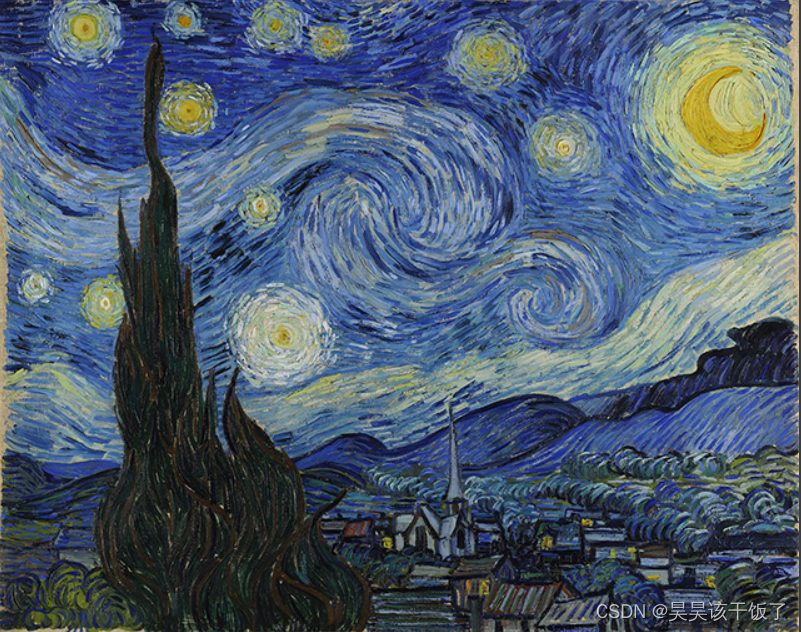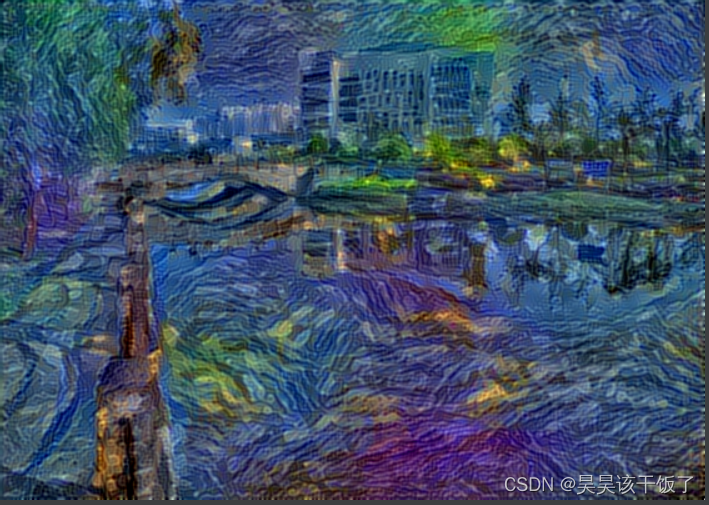样例
风格迁移前


风格迁移后

实战环节
导入我们所需要的库包
from __future__ import print_function
from keras.preprocessing.image import load_img, img_to_array
from scipy.misc import imsave
import numpy as np
from scipy.optimize import fmin_l_bfgs_b
import time
import argparse
from keras.applications import vgg16
from keras import backend as K
定义参数
parser = argparse.ArgumentParser(description='Neural style transfer with Keras.')
parser.add_argument('--base_image_path', metavar='base', default='1-content.jpg',type=str,
help='Path to the image to transform.')
parser.add_argument('--style_reference_image_path', metavar='ref', default='1-style.jpg',type=str,
help='Path to the style reference image.')
parser.add_argument('--result_prefix', metavar='res_prefix' ,default='1-output.jpg',type=str,
help='Prefix for the saved results.')
parser.add_argument('--iter', type=int, default=2, required=False,
help='Number of iterations to run.')
parser.add_argument('--content_weight', type=float, default=0.025, required=False,
help='Content weight.')
parser.add_argument('--style_weight', type=float, default=1.0, required=False,
help='Style weight.')
parser.add_argument('--tv_weight', type=float, default=1.0, required=False,
help='Total Variation weight.')
编写各部分函数及功能实现
args = parser.parse_args()
base_image_path = args.base_image_path
style_reference_image_path = args.style_reference_image_path
result_prefix = args.result_prefix
iterations = args.iter
# these are the weights of the different loss components
# 这些是不同损失分量的权重
total_variation_weight = args.tv_weight
style_weight = args.style_weight
content_weight = args.content_weight
# dimensions of the generated picture.
# 生成的图片的尺寸。
width, height = load_img(base_image_path).size
# img_nrows = 400
img_nrows = height
# img_ncols = int(width * img_nrows / height)
img_ncols = width
def preprocess_image(image_path):
img = load_img(image_path, target_size=(img_nrows, img_ncols))
img = img_to_array(img)
img = np.expand_dims(img, axis=0)
img = vgg16.preprocess_input(img)
return img
# util function to convert a tensor into a valid image
# 将张量转换成有效图像的util函数
def deprocess_image(x):
if K.image_data_format() == 'channels_first':
x = x.reshape((3, img_nrows, img_ncols))
x = x.transpose((1, 2, 0))
else:
x = x.reshape((img_nrows, img_ncols, 3))
# Remove zero-center by mean pixel
x[:, :, 0] += 103.939
x[:, :, 1] += 116.779
x[:, :, 2] += 123.68
# 'BGR'->'RGB'
x = x[:, :, ::-1]
x = np.clip(x, 0, 255).astype('uint8')
return x
# get tensor representations of our images
base_image = K.variable(preprocess_image(base_image_path))
style_reference_image = K.variable(preprocess_image(style_reference_image_path))
# this will contain our generated image
if K.image_data_format() == 'channels_first':
combination_image = K.placeholder((1, 3, img_nrows, img_ncols))
else:
combination_image = K.placeholder((1, img_nrows, img_ncols, 3))
# combine the 3 images into a single Keras tensor
input_tensor = K.concatenate([base_image,
style_reference_image,
combination_image], axis=0)
# build the VGG16 network with our 3 images as input
# the model will be loaded with pre-trained ImageNet weights
model = vgg16.VGG16(input_tensor=input_tensor,
weights='imagenet', include_top=False)
print('Model loaded.')
# get the symbolic outputs of each "key" layer (we gave them unique names).
outputs_dict = dict([(, layer.output) for layer in model.layers])
# compute the neural style loss
# first we need to define 4 util functions
# the gram matrix of an image tensor (feature-wise outer product)
def gram_matrix(x):
assert K.ndim(x) == 3
if K.image_data_format() == 'channels_first':
features = K.batch_flatten(x)
else:
features = K.batch_flatten(K.permute_dimensions(x, (2, 0, 1)))
gram = K.dot(features, K.transpose(features))
return gram
# the "style loss" is designed to maintain
# the style of the reference image in the generated image.
# It is based on the gram matrices (which capture style) of
# feature maps from the style reference image
# and from the generated image
def style_loss(style, combination):
assert K.ndim(style) == 3
assert K.ndim(combination) == 3
S = gram_matrix(style)
C = gram_matrix(combination)
channels = 3
size = img_nrows * img_ncols
return K.sum(K.square(S - C)) / (4. * (channels ** 2) * (size ** 2))
# an auxiliary loss function
# designed to maintain the "content" of the
# base image in the generated image
def content_loss(base, combination):
return K.sum(K.square(combination - base))
# the 3rd loss function, total variation loss,
# designed to keep the generated image locally coherent
def total_variation_loss(x):
assert K.ndim(x) == 4
if K.image_data_format() == 'channels_first':
a = K.square(x[:, :, :img_nrows - 1, :img_ncols - 1] - x[:, :, 1:, :img_ncols - 1])
b = K.square(x[:, :, :img_nrows - 1, :img_ncols - 1] - x[:, :, :img_nrows - 1, 1:])
else:
a = K.square(x[:, :img_nrows - 1, :img_ncols - 1, :] - x[:, 1:, :img_ncols - 1, :])
b = K.square(x[:, :img_nrows - 1, :img_ncols - 1, :] - x[:, :img_nrows - 1, 1:, :])
return K.sum(K.pow(a + b, 1.25))
# combine these loss functions into a single scalar
loss = K.variable(0.)
layer_features = outputs_dict['block4_conv2']
base_image_features = layer_features[0, :, :, :]
combination_features = layer_features[2, :, :, :]
loss += content_weight * content_loss(base_image_features,
combination_features)
feature_layers = ['block1_conv1', 'block2_conv1',
'block3_conv1', 'block4_conv1',
'block5_conv1']
for layer_name in feature_layers:
layer_features = outputs_dict[layer_name]
style_reference_features = layer_features[1, :, :, :]
combination_features = layer_features[2, :, :, :]
sl = style_loss(style_reference_features, combination_features)
loss += (style_weight / len(feature_layers)) * sl
loss += total_variation_weight * total_variation_loss(combination_image)
# get the gradients of the generated image wrt the loss
grads = K.gradients(loss, combination_image)
outputs = [loss]
if isinstance(grads, (list, tuple)):
outputs += grads
else:
outputs.append(grads)
f_outputs = K.function([combination_image], outputs)
def eval_loss_and_grads(x):
if K.image_data_format() == 'channels_first':
x = x.reshape((1, 3, img_nrows, img_ncols))
else:
x = x.reshape((1, img_nrows, img_ncols, 3))
outs = f_outputs([x])
loss_value = outs[0]
if len(outs[1:]) == 1:
grad_values = outs[1].flatten().astype('float64')
else:
grad_values = np.array(outs[1:]).flatten().astype('float64')
return loss_value, grad_values
# this Evaluator class makes it possible
# to compute loss and gradients in one pass
# while retrieving them via two separate functions,
# "loss" and "grads". This is done because scipy.optimize
# requires separate functions for loss and gradients,
# but computing them separately would be inefficient.
class Evaluator(object):
def __init__(self):
self.loss_value = None
self.grads_values = None
def loss(self, x):
assert self.loss_value is None
loss_value, grad_values = eval_loss_and_grads(x)
self.loss_value = loss_value
self.grad_values = grad_values
return self.loss_value
def grads(self, x):
assert self.loss_value is not None
grad_values = np.copy(self.grad_values)
self.loss_value = None
self.grad_values = None
return grad_values
evaluator = Evaluator()
# run scipy-based optimization (L-BFGS) over the pixels of the generated image
# so as to minimize the neural style loss
if K.image_data_format() == 'channels_first':
x = np.random.uniform(0, 255, (1, 3, img_nrows, img_ncols)) - 128.
else:
x = np.random.uniform(0, 255, (1, img_nrows, img_ncols, 3)) - 128.
for i in range(iterations):
print('Start of iteration', i)
start_time = time.time()
x, min_val, info = fmin_l_bfgs_b(evaluator.loss, x.flatten(),
fprime=evaluator.grads, maxfun=20)
print('Current loss value:', min_val)
# save current generated image
img = deprocess_image(x.copy())
fname = result_prefix + '_at_iteration_%d.png' % i
imsave(fname, img)
end_time = time.time()
print('Image saved as', fname)
print('Iteration %d completed in %ds' % (i, end_time - start_time))




